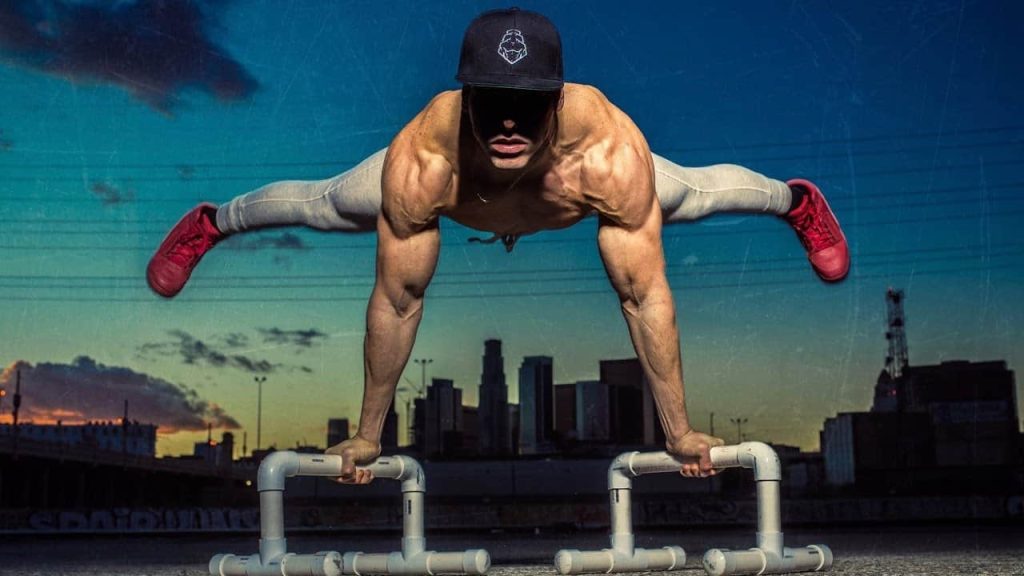One of the best parts of being a beginner in the world of training and athletics is discovering what your body can do.
The pursuit to become bigger, better, faster, and stronger awakens a fire within that will motivate you to challenge your limits.
Calisthenics are bodyweight exercises in which your body’s relationship with gravity creates the resistance. These movements are fundamental for athletes from all walks of life and at all levels of experience. Calisthenic exercises incorporate aspects of balance and coordination, resistance, and mobility to help you build strength and muscular endurance.
Here’s a complete guide to calisthenics for beginners.
What Are Calisthenics?
As mentioned before, calisthenics are a form of bodyweightexercise that create a strong foundation for improved fitness. Calisthenics training can help you create the body you want, while helping you develop flexibility, cardiovascular, and muscular endurance.
Simplicity is a good word to describe calisthenic exercises. This type of training uses all the classics— air squats, push-ups, pull-ups, etc.,— with increased intensity and advanced positions over time. While bodyweighttraining might sound like a basic exercise, that doesn’t make it easy.
Bodyweighttraining is versatile, with variations and modifications to make the movement more accessible to beginners or more intense for progression.
Once you have good comprehension of these movements and their variations, you can structure your workouts to develop all of your body parts while experiencing a wide range of benefits.
Read Also: Top 6 Best Outdoor Pull-up Bars and related accessories (2022 Review)
What Are The Benefits of Doing Calisthenics?
There are numerous benefits of incorporating calisthenics exercise movements into your training. Some of the primary benefits include:
Everyone Can Do Calisthenics
You can do calisthenic exercises even if you’ve never worked out before. The beauty of calisthenic movements is no matter your athletic ability, you can do a variation of them.
When starting calisthenics for beginners, modifying movements is a common practice. If regular push-ups are too difficult; you can start on your knees, or inclined with a chair. If full bodyweight dips are too advanced, you can start with a modified chair dip at home.
With the infinite number of calisthenic moves and variations, there’s no better way to start training.
You Can Do Calisthenics Anywhere
You can do calisthenics training anywhere, anytime. Whether you’re at the gym or doing an outdoor street workout in your cul-de-sac. Since you don’t need expensive gym equipment to squat or do push-ups, this form of training is great for busy individuals with limited resources. When you need equipment, there’s always a chair or playground readily available to act as a bench or pull-up station.
Read Also: Bodyweight Chest Exercises to build a Godly chest
You Can Perfect Your Timing
The simplicity of calisthenics is one of the reasons why this routine is perfect for individuals who are busy, or who are always on the go. Even if you’re working for at least eight hours a day, you can wake up extra early or spend time in the evening to do some calisthenics.
This routine will not require a lot of equipment or time. If you only have ten minutes to workout today, that’s plenty. As long as you’re consistent and dedicated with your efforts, you’ll be enjoying the benefits of calisthenics in no time.
Calisthenics are Affordable
Can’t afford a gym membership? No problem.
Not everyone has the finances to regularly pay for monthly gym memberships or to set up a robust at-home gym for weight exercises. Anyone from any financial background can start a calisthenics journey, whether it’s a college student or a busy single mom.
Creates a Foundation for StrengthTraining
Those basic calisthenics exercises do more than burn body fat and build muscle mass. Learning the basic movements before adding weight will help you stay strong throughout the entire range of motion. Learning the functional movement of a bodyweightsquat with proper form will prepare you for a barbell squat later on. This form of training will help you reduce the risk of injury if you want to progress to weighttraining.
Read Also: The elevated benefits of Weighted Pull Ups
Work Smarter, Not Harder
Many of the movements in calisthenic training are compound exercises. This means that they engage more than one muscle group, rather than targeted isolation movements. In essence, you can get a full-body workout in less time with a calisthenics workout plan.
Essentially, with calisthenics, you’re no longer beholden to anything to get a good workout in.
Read Also: Best Bands to Help you with your Pull Up Progression
Myths About CalisthenicTraining
There’s a lot of misinformation about calisthenics for beginners that prevents people from giving it a try. Let’s dispel some of those myths.
A BodyweightWorkout Isn’t Effective
Many people incorrectly assume that a bodyweightworkout isn’t as effective as weighttraining. While you won’t be able to walk up to a barbell and squat 800 pounds after squatting only your body weight for years, it’s incredibly effective for fat loss, muscular strength and endurance, and muscle mass building.
Read Also: How to develop tree trunk legs with Calisthenics Leg Workout
You Can’t Progress with a Calisthenics Routine
When you use equipment-based strength exercises, progressive overload is intuitive: you add more sets or reps, or pick up a heavier dumbbell. The same theory applies to a bodyweightworkout program. Start by adding more sets or reps in your calisthenics workout routine. Then, intensify the movement. For example, your push-ups might progress to a handstand push-up over time. You might add unilateral training to your squats by progressing to a pistol squat.
Still not satisfied?
Grab a resistance band or try some weighted calisthenics using free weights or objects from around your house— the Strongman community has been doing it for years. You can even combine calisthenics with exercises you can do on a dip bar to achieve better, and faster results.
CalisthenicTraining is for Men/Women
Depending on which side of the internet you stumble upon, you might find that calisthenics are only for men or only for women. The former idea comes from the archaic theory and misinformation about women and strengthtraining. The latter comes from the archaic idea that bodyweighttraining is easy and that you need big weights to showcase strength or fitness.
Both theories are garbage; calisthenics are for everyone.
Read Also: Why bodyweight lunges are a key to building incredibly powerful legs
How To Do Calisthenics For Fat Loss?

The cool thing about calisthenics is, once you understand basic movements and progressions, you can create whatever type of workout you want with these exercises. If your main goal is fat loss or leaning down, you can do just that! You can easily adjust the intensity of your workout, so you can achieve your fitness – regardless if it includes losing weight or building muscles.
Both cardiovascular motions – getting your heart rate up into a “fat burning zone” – and strength training are awesome ways to burn calories and, once your glycogen stores are used up, body fat. A combination is best. Structures like tabata and HIIT are perfect to compliment calisthenics, because these are quick, one after the other workouts where you can’t necessarily move from machine to machine (or worse, involve heavy free weights). It’s safe to go fast and hard with calisthenics exercises, so you can get improved physique fast.
For fat loss, you’re looking to burn the most amount of calories in the least amount of time. This drains your glucose stores and starts to target your stored body fat (more on this later). The more fatigued you get, the more blood you get pumping, the more fat will be burned. Of course, this is coupled with a tremendous diet, but we’ll cover that in a few sections.
Read Also: How to use box jump workouts to level up your fitness
How To Do Calisthenics For Building Muscle?

This one is hard to believe. I mean, bodyweight exercises for adding muscle? Sounds almost too good to be true.
Calisthenics are good for building solid muscle relative to your body weight, but they will only take you so far. Other kinds of strengthtraining, like Olympic training or bodybuilding, are the best for bigger strength gains and targeted, isolated muscle growth.
Not only will a calisthenics workout routine help you build decent muscle, it will be full muscle. For example, if you were to rep out on bench press, your hands go only so far – the bar touches your chest and you go back up. However, if you were to do a decline push-up with parallel bars (which can be done) and went down, you can surpass your chest and go as far as possible, extending your range of motion and fully utilizing each muscle group.
As long as you keep progressing with your movements, your body will be getting stronger. If you’re getting stronger, you’re going to build muscle to take on the increased load.
Read Also: The best Calisthenics equipment for building a home gym
Calisthenics vs. Weights, Which Is Better?
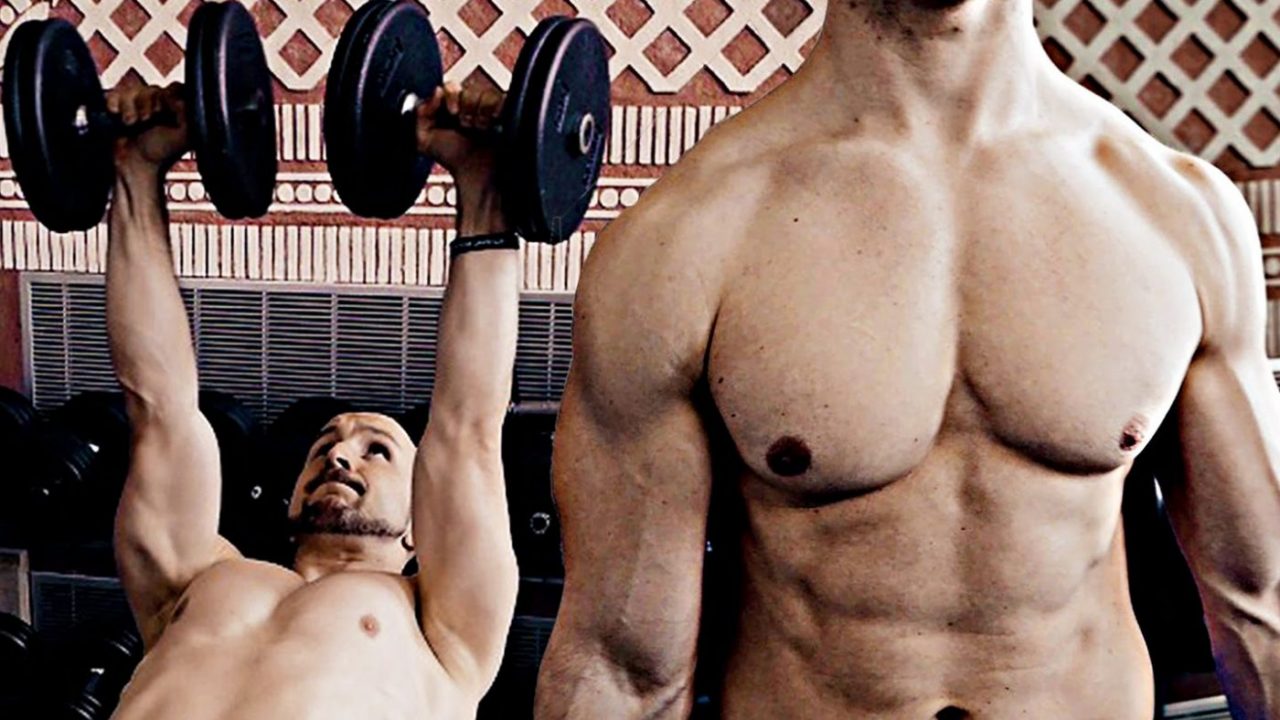
As we’ve briefly touched upon, calisthenics and weight training each have their pros and cons.
On one side, there’s weightlifting.
A traditional way to get in shape, and the second most popular thing to do at the gym (right behind the boring treadmill, although curved treadmills can be pretty fun!).
Here are a few benefits of slinging around free weights and using multiple machines:
- You get stronger and build muscle faster.
- At a gym, you get access to a wide range of exercises.
- It’s easy to track progress – it’s the weight itself!
- You know which exercise targets which muscle, making it very specific and isolated.
Read Also: Best Calisthenics Apps and Programs to follow
Then on the other side, you have calisthenics. You know of the benefits of these bodyweight exercises, but compared to weightlifting:
- You still build muscle, but at a slower pace.
- The world is your gym, with 24-hour access!
- It’s a little tougher to track your progress, but as long as you know the variations, you can keep moving forward without a hitch.
- Almost all of the exercises are compound, so you work multiple muscles at the same time. This is healthier in the long run. You will be thankful when you reach the elderly years when certain muscle groups become essential just for daily living.
So they each have their advantages. Take these into consideration when you decide which is right for you.
It might result that you involve both in your workout strategy, or it’s simply one or the other.
Whatever you decide, make sure it coincides with what you enjoy doing, in order to make it a consistent, sustainable habit.
How To Start Calisthenics Workouts?
The way to begin your bodyweight journey is to learn the basics. Of course, you have push-ups, pull-ups, air squats, hamstring curls, handstand push-ups or pike push-ups, dips, and Australian pulls, and sprints. (Don’t worry, these will be covered in depth later.) With a few key movements, you can create a workout plan based on those and their respective variations.
For the first week or so, familiarize yourself with these bodyweight movements. Some of them might be a bit awkward when you’re just starting out, but that’s only because there’s zero muscle memory. Once you get the hang of the classics, up the reps and challenge yourself until it’s time to learn a new, harder variation.
The best way to structure a calisthenics workout schedule is to group together similar body parts: push muscles and pull muscles or upper body and lower body. You can work these as often as you want, put two of them together on the same day, or go full body three times a week.
The important thing to remember is you’ll want to target each group of muscles every 48-96 hours or so, to maximize muscle and strength gains while allowing your body to rest and recover.
Read Also: Best Power Towers with Pull Up and Dip Stations
Calisthenics Schedule for Beginners
An example workout routine might look like this:
Monday | Push day (chest, triceps, shoulders) |
Tuesday | Pull day (backs, biceps, traps) |
Wednesday | Leg day (quads, glutes, hamstrings, calves) |
Thursday | Active rest (walking, sports, etc.) |
Friday | Push day (chest, triceps, shoulders) |
Saturday | Pull day (backs, biceps, traps) |
Sunday | Leg day (quads, glutes, hamstrings, calves) |
You can throw core or ab exercises in there too, but surprisingly most if not all of these compound exercises should involve you contracting your core. Direct abdominal movements have the same effects as indirect movements.
What Is The Basic Calisthenics Equipment?

A great reason to go with calisthenics as your workout of choice is the equipment needed. What you need is:
- Your body
- Floor space
- A horizontal bar that’s just out of reach above you. If you don’t have a park or bar near you, we recommend one of these outdoor pull up bars for good weather days.
- A set of parallel bars at hip height
That’s the basics, though you can get away with just your body and some room to move to start. That will cover your push exercises and abdominal movements, as well as most leg work. The horizontal bar is needed for both pulling work and hanging ab exercises. And the short parallel bars are mainly used for dips and Australian pulls.
These items can be found at any local park, school gymnasium, or you could even make your own set in your backyard! The fact that you can find a monkey bar setup and parallel bars for free in your neighborhood is a wonderful way calisthenics can give you the gift of fitness on the cheap.
Calisthenics Stretching/Warm-Up for Beginners
Any workout is only as good as their warm-up routine. Before you throw yourself into your reps and sets, you’ll want to include some dynamic stretching, such as Frankensteins, high knees, butt-kickers, self hugs, arm circles (forwards and backwards), shuffles, and lunges with twists.
As well, you’ll want to do a static cool-down routine at the end of your beginner calisthenics workout to keep your muscles and joints pliable and loose. Without a proper warm-up and cool-down, you run the risk of injury and increased DOMS (delayed onset muscle soreness).
It’s a necessary, vital part of the workout, so get it done and get it out of the way.
Read Also: Warm up with these Calisthenics exercises to prevent injury
Rules When Performing Calisthenics Exercises
You want the most out of your calisthenics training session. You also want to avoid injury at all costs. Therefore, there are some simple tenets you need to abide by in order to use your beginner calisthenics workouts for your health:
- Use PERFECT form: You aren’t going against anyone else when you’re doing calisthenics. You’re only trying to better yourself. With that in mind, starting the habit of establishing correct form for each exercise is a must. By never faltering on form, you ensure you steer clear of injury and get the most out of every rep. When you start to lose form, please, for the love of everything holy, STOP.
- Be present and mindful during the workout: Your brain needs to be focused on the task (er, muscle) at hand. If you’re doing pull-ups, put all of your mindfulness into that squeeze in your back. It’s why they call it “mind-muscle connection.”
- Quality > Quantity: To continue the perfect form rule, doing four quality reps will do a world of difference, while twenty terrible reps only develop bad habits, muscles that compensate for other underdeveloped muscles, and risk of hurting yourself.
- Breathe to your advantage: Inhale on the concentric (squeeze) part of the movement, exhale on the eccentric (release) of the movement. If you hold your breath, your muscles don’t get oxygen, and your workout will suffer as a result. Don’t kill yourself — breathe into your muscles and give them the energy they need to crush PRs.
Adopt progressive overload: Always get stronger. Period. The point of exercising isn’t to do the same reps, sets, time under tension, and overall load. The point is to increase the volume each and every workout. Sure, keep most variables constant, but have one variable change so that you’re doing more work with every consecutive session. Your body will be better because of this.
Read Also: 10 Resistance band exercises for Seniors
Calisthenics Sets and Reps
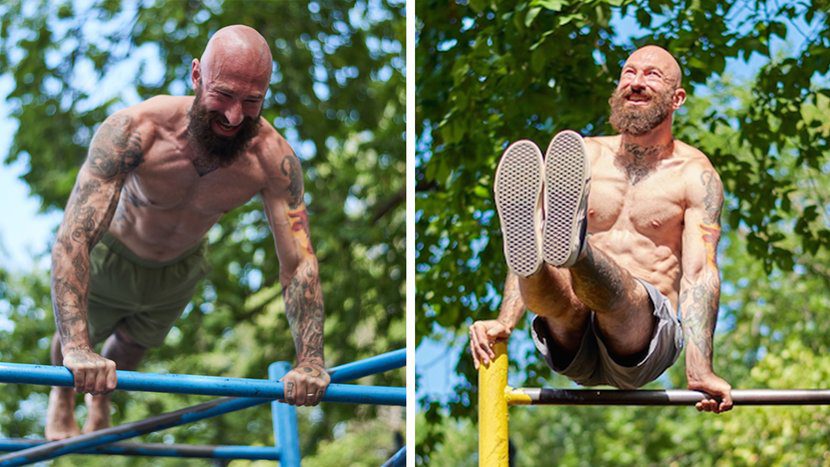
The amount of sets you do depends on your energy levels for the day. A good range to stay in is 3-4 sets. You can make your sets one exercise at a time, or doing them one after the other as a circuit and repeat the lineup 3 or 4 times.
For reps, there is science behind this. There are three ranges, each developing something different:
- 1-4 reps = Maxing out or power
- 5-8 reps = Strength and conditioning the movement
- 8-15 reps = Muscular growth or muscular hypertrophy
So, for building muscle mass and burning body fat, a good way to progress is to start a new exercise in the 5-8 rep range, and then, once you’re confident in the motions, go up to the 8-15 rep range. You don’t need the 1-4 rep range unless you’re going for a max in something; in calisthenics, what exactly would that be?
Once you max out the range – 3 or 4 sets of 15 reps each – move to the next hardest variation. For example, once you can perform Australian pulls 4×15, switch to front lever raises with your knees tucked, and go back to a 3×5-8 set/rep setup.
Read Also: Pistol Squat Progression – Get incredibly strong legs with this one Calisthenics exercise
Beginners Calisthenics Workout
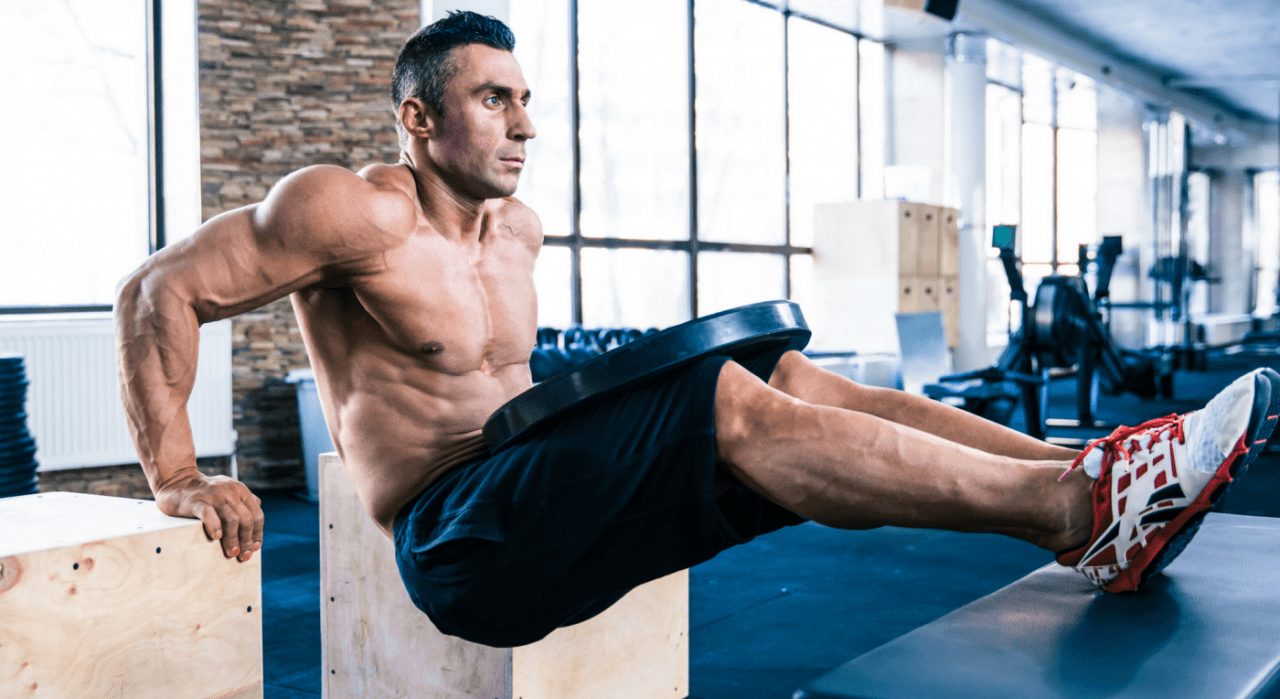
A Day (twice per week):
- Push-ups: 3×5-15
- Dips: 3×5-15
- Pike Push-ups: 3×5-1
B Day (twice per week):
- Pull-ups or Chin-ups: 3×5-15
- Australian Pulls: 3×5-15
- Hanging Knee Tucks: 3×5-15
C Day (once or twice per week):
- Air Squats: 3×5-15
- Hamstring Curls: 3×5-15
- Sprints: 3×40 yards
This may seem simple, but if you limit resting time between sets and go as hard as you can, you will start to feel the burn and you’ll see why calisthenics are tremendous for both building muscle and burning body fat.
Read Also: 8 Treadmill exercises for beginners and weight loss
Beginner Calisthenics Workouts for Target Areas:
Legs
We get it. You want thick, strong, powerful legs to carry you to the promised land in your sport. Or you want to be able to jump really, really high. (Just for kicks.)
Luckily, we have just the workout for you to build those tree-trunk legs right here.
Shoulders
Boulder shoulders are an obvious sign of athletic build and an amazing physique. But sometimes, they can be stubborn as hell.
However, we have just the ticket to defeat that stubbornness and have your shoulders blow up. Our shoulder-focused calisthenics workout gets you those boulders!
Back
You might not know this, but your posterior chain is the most important part of your muscular body. It helps you stay upright, it aids your core, and we all neglect it with slouched positions at desk jobs and improper posture.
So here is a quick and easy beginner calisthenics workout for your back:
- Pull-ups or Push-ups: 3 sets x 8-12 reps
- Australian Rows: 3 sets x 15-20 reps
- Reverse Push-up w/ 1-second squeeze at the top*: 3 sets x 20 reps
- Floor LAT Pulls**: 3 sets x 10-15 reps
- (Optional) Lever Pulls: 1 set x failure
*Lay on your back with knees up and feet close to your bum. With your elbows on the floor at a 45-degree angle, push up with your elbows, squeezing your back as you lift your upper body. Return to the floor. That’s one rep.
**Using a towel for your knees, get in the same position you would for ab wheel rollouts. With hands on the floor in front of you, slide your entire body forward into a push-up position with your knees still on the towel. This mimics a LAT pull-down or a pull-up.
Chest
Building up your chest is just as vital as your back. So here is a quick and easy chest calisthenics workout for beginners:
- 100 Decline Push-ups
- 100 Wide Push-ups
- 100 Narrow Push-ups
- 100 Incline Push-ups
- 100 Dips
Trust us, 500 reps will blow your chest up! To progress on this workout, try to get it done as quickly as possible (with proper form) and get better times over…time.
Abs
The always-coveted echelon of a top physique — six-pack abs. You want ‘em, we got the exact workout to get ‘em. If you follow our calisthenics abs workout to the letter and are consistent with doing it three-to-four days per week, you’ll definitely see some progress.
Beginner Calisthenics Workout at Home
We get it. You want to work out in the comforts of your own home. And we don’t blame you.
That’s why we’ve created a super-effective, simple to comprehend at-home calisthenics workout. It’s our beginner calisthenics workout from above. Yes, you can easily perform all of these movements in your garage or backyard.
Beginner Calisthenics Workout with No Equipment
The beauty of calisthenics is that you can get stronger and bigger with absolutely zero pieces of equipment. Want proof? Here’s a workout that involves you and the floor and nothing else:
- Push-ups: 2 sets x failure
- Floor LAT Pulls: 2 sets x failure (okay, fine, this involves a towel…but you have a towel, right?)
- Jump Squats: 2 sets x failure
- Lunges: 2 sets each side x 20-30 reps
- Pike Push-ups: 2 sets x failure
- Calf Raises: 2 sets x failure
- Planks: 2 sets x 2-3 minutes
- Mountain Climbers: 1 set x failure
This workout can kick your butt, and that’s without any equipment. That means you can get in a sweat anywhere, anytime, without anything else but yourself and the determination to be better.
Beginner Calisthenics Workout for Overweight Beginners
We understand if you’re at a point in your life where you feel like you can’t do many of these exercises due to excess weight. It’s a tough situation to be in, but thankfully it doesn’t have to stay that way. There are a few calisthenics exercises you can do while overweight to build some muscle, lose fat, increase cardiovascular health, and reach a point where you can try out some of the other workouts in this article.
Here’s the workout:
- Incline Push-ups (whatever angle you can do to get consecutive reps): 2 sets x 10-20 reps
- Australian Rows (whatever angle you can do to get consecutive reps): 2 sets x 10-20 reps
- Air Squats (as low as you can go): 2 sets x 10-20 reps
- Lunges (as low as you can go): 2 sets x 10-20 reps
- Jumping Jacks: 3 sets x 30 seconds
- End with a 20- to 30-minute walk
Read Also: Build full body functional strength with these Sandbag Workouts
Calisthenics Beginner Progression
Why do you want to work out in the first place? Probably to see progress. And if you implement progressive overload (a.k.a. increasing the volume over time), you will see some of that coveted progress.
But we want to be clear: Progress is NOT linear. What we mean by that is some weeks you’ll look in the mirror and not recognize yourself. And other weeks you’ll see your body and wonder what the point is, you look like you did a month ago.
We’re here to set expectations — realistic expectations — for your calisthenics workouts. At the beginning, you might see a lot of changes. But eventually, you’ll hit what’s called a plateau. Everybody does. The trick is to keep going and burst through that plateau. Because if you don’t, you’ll stop your workout and revert back to your old, unhealthy self (and you might slip even further down that bad slope).
So be excited for any progression you see, celebrate your accomplishments. But please, please, please, don’t get discouraged if you no longer see progress. Your internal body is still improving, and you’ll get past the sticking point.
A quick tip is to take progress pictures. That way you won’t mislead yourself into thinking you aren’t changing. (We can guarantee that you actually are, and for the better!)
A Summary of the Calisthenics Workout Tips for Beginners
- Workouts should be playful — it’s the stuff we did as kids, after all — but remember to play hard.
- Progress is NOT linear. But look to progress a little bit each and every workout.
- Make sure to work out your whole body — don’t skip leg day!
- Don’t under-train, don’t over-train; find that sweet spot, rest when you need to, work out with intensity when you feel energized.
- Have fun with it, but stay safe.
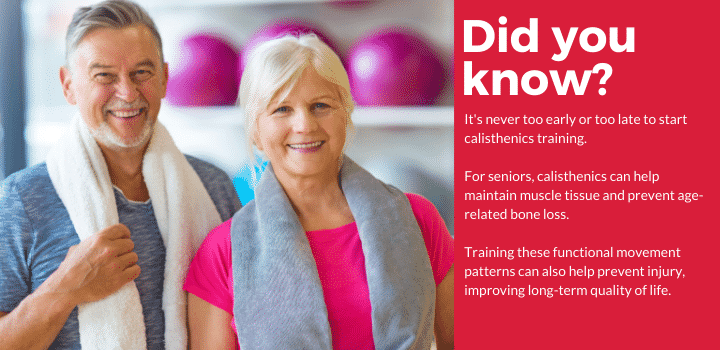
What About A Calisthenics Diet?
A solid diet is pivotal for the fat burning aspect of calisthenics.
To burn body fat, you have to use your fat for energy. To do that, you can’t have glucose, the primary energy source for your body, stored.
Glucose is stored when you eat enough food and your body doesn’t need all of it at that moment; it stores the extra glucose – body sugar – for later.
Before you eat at the beginning of your day, your glucose stores are low, probably even depleted.
With no glucose in your body, getting out of bed, getting dressed, and coming down the stairs is being fueled by your body fat. This is why fasting has become such a trend lately.
Intermittent fasting while working out is a fantastic tool if your goal is to lose body fat. Other than that, a diet high in nutritious foods is ideal.
Plants, such as vegetables, fruits, legumes, and some starches, should be the focal point of your diet.
Healthy fats and healthy protein sources are also important. If you can fast, workout, and break your fast with 80% plants, you’re well on your way to a healthy lifestyle and a body built by bodyweight exercises and nutrition.
Resources on Calisthenics
Books
There are a range of books available on the subject of calisthenics.
Fitness Tracking Apps
Grabbing your favorite fitness tracker is a terrific way to measure your data. What gets measured gets managed, and you definitely need to measure your workouts and biological data in order to progress. When you get an app or wearable device, make sure you get something that tracks things like heart rate variability (HRV), body fat percentage, activity, sleep (which is an important part of rest), and more.
Conclusion
Calisthenics are wonderful for creating the physique of your dreams. While they might not build muscle as fast as traditional weightlifting, they can still help you develop muscle. They can also help burn body fat, so long as you workout quickly and use intermittent fasting and nutritious fuel. The benefits are nearly endless, and starting is incredibly easy. Use the sample workout as a template; build off of it, create HIIT elements, learn new moves, advance to cool exercises with practical application in the real world.
Calisthenics are the ultimate bodybuilder if you’re on a budget or in a time crunch or wanting to practice amazing skills. It’s a collection of universal movements; master them, and you will be unstoppable.

